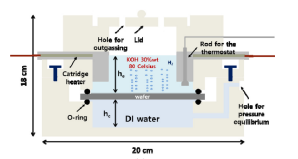Wet etching is more economical than dry etching and provides a uniform etching depth regardless of wafer sizes. Typically, potassiumhydroxide (KOH) and tetra-methyl-ammonium hydroxide (TMAH) solutions are widely used for the wet etching of silicon. However,there is a limit to the wet etching process when a material deposited on an unetched surface reacts with an etching solution. To solvethis problem, in this study, an apparatus was designed and manufactured to physically block the inflow of etchants on the surface usinga rubber O-ring. The proposed apparatus includes a heater and a temperature controller to maintain a constant temperature during etching, and the hydrostatic pressure of the etchant is considered for the thin film structure. A corrugation membrane with a diameter of800 µm, thickness of 600 nm, and corrugation depth of 3 µm with two corrugations was successfully fabricated using the prepareddevice.
The development of silicon wafer-based micromachiningprocesses has made it possible to develop devices with variousmechanical structures as well as semiconductor processes, whichhas led to the commercialization of micro-electro-mechanicalsystem (MEMS) devices. MEMS sensors can react sensitively tosmall physical quantities owing to their small micron-sizedstructures. Thus, they are used in various fields, including acousticand vibration transducers and sensors that detect various chemicalsubstances [1-3]. For a simple cantilever structure [4], a thinmembrane structure with a thickness of less than 1 µm [5], and astructure such as a comb-drive [6], etc. are mainly used, and a moresophisticated fabrication process to improve the performance oftransducers is required.
Etching can be of two types: wet and dry etching. In dry etching, because reactive gases and ions are used, the process isperformed in a vacuum environment. Reactive-ion etching (RIE)is a type of dry etching. As dry etching is generally anisotropic, itis widely used in fabrication processes involving microstructureswith high aspect ratios, such as semiconductors and MEMStransducers [7]. However, precision equipment is required, and theprocess is expensive. Furthermore, when performing a deep etch,the uniformity within the wafer is relatively poor [8]. This is aproblem with processes involving a thin membrane structure. Toform a thin membrane over the entire wafer, the patterns in thecenter must be over-etched because of the nonuniform etch rate;thus, there is a high possibility that the membrane can bedestroyed or damaged.
Wet etching is generally isotropic, and a chemical reactionoccurs between a wafer and an etchant. For anisotropic wetetching, etching is performed using the difference in etch rateaccording to the lattice direction. The etching of silicon isperformed using KOH and TMAH. As wet etching can be carriedout with a simple preparation and the etching rate is relatively fast,it is preferred and widely used in etching deeper than 10 μm, e.g.,creating a cantilever structure or a thin membrane structure.

Fig1
The practical drawback of wet etching is that the entire wafer is immersed in a solution to carry out the process; thus, it may be damaged if the unetched side is not coated with a passivation layer. For instance, if there is a MOSFET that has a CMOS on the front side (or a metal such as aluminum that easily reacts with KOH), wet etching is impossible [9,10]. As it is not possible tocreate a protective film using a photoresist when performing KOHwet etching, a protective film using poly-methyl-methacrylate(PMMA) has been suggested, but it has been reported that theadhesion between PMMA and the silicon wafer becomes aproblem when etching is performed at a high temperature for along time.
To overcome this problem, a method of physically blocking theetchant and the substrate using a mechanical structure and an Oring has been proposed (instead of chemically covering theprotective film) [12-15]. However, in the case of the reporteddevice, the temperature is not controlled by itself; instead, theentire device is immersed in a KOH bath maintained at a constanttemperature, or an additional device, such as an auto-levelingsystem to maintain a constant etchant level is required. Inaddition, in this method, as the wafer and etchant are in contact atonly one side (to form a structure, such as a very thin film of 1 µmor less), it is important to balance the pressure (considering thehydrostatic pressure). In the previous study, this aspect was notconsidered, and a detailed description of the method for adjustingthe pressure was not presented.
To overcome this problem, a method of physically blocking theetchant and the substrate using a mechanical structure and an Oring has been proposed (instead of chemically covering theprotective film) [12-15]. However, in the case of the reporteddevice, the temperature is not controlled by itself; instead, theentire device is immersed in a KOH bath maintained at a constanttemperature, or an additional device, such as an auto-levelingsystem to maintain a constant etchant level is required. Inaddition, in this method, as the wafer and etchant are in contact atonly one side (to form a structure, such as a very thin film of 1 µmor less), it is important to balance the pressure (considering thehydrostatic pressure). In the previous study, this aspect was notconsidered, and a detailed description of the method for adjustingthe pressure was not presented.